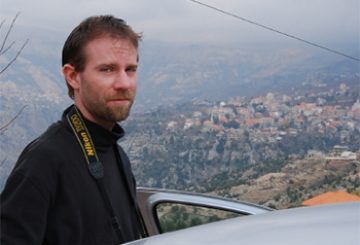Lally Katz is pondering the possibility of growing up. “Every now and then I’ll try it,” she muses down the phone line. “I’ll tell myself, ‘I’ve got to grow up, I’ve got to grow up’, but it never works. There have been a lot of failed attempts on my part to try to be a grown-up.”
Failed attempts at growing up, perhaps, but the playwright has certainly succeeded in making her mark. Earlier this month, Katz’s Goodbye Vaudeville Charlie Mudd, which premiered at Melbourne’s Malthouse Theatre in March, took on a strong field at the Victorian Premier’s Literary Awards to win the Louis Esson Prize for Drama.
Her hour-long piece When the Hunter Returns, written for the Gaiety School of Acting in Dublin, is set to open the Dublin Theatre Festival later this month. She has just been awarded a British Council Realise Your Dream scholarship, which will see her fly to Britain next year to work and network with writers and theatre-makers.
Next month Katz makes her debut at the Melbourne Theatre Company and at the Melbourne International Arts Festival with the premiere of Apocalypse Bear Trilogy. “It’s kind of a Melbourne dream to be doing this,” she says.
Dream or nightmare? Katz’s Apocalypse Bear is a character who has appeared in so much of her work that he has become almost real to her, she says. The idea for the character came when Katz, in the gift section of a pharmacy, found a plaster merry-go-round with little bears on it.
“I remember thinking: ‘Who would buy this? Who would come into a pharmacy and buy this?’ And I looked at these bears for a little while and thought: ‘You know what? You’re Apocalypse Bears. That’s what you are. And I know who can buy you. Me.'”
The bears made their first appearance at the end of Lally Katz and the Terrible Mysteries of the Volcano, before reappearing in Hip Hip Hooray, which Katz wrote for the Sydney Theatre Company’s Wharf2Loud program. “After that, for about three years, I just hung out with him,” Katz says of the bear. “He kind of became real to me. Everywhere I’d go I’d see him. I’d see him coaching a kid’s football team at dusk on the oval. I’d see him sitting on the tram. Sometimes I’d go for a run and he’d be there, running along with me.”
“It was a little like having an imaginary friend, but with a really heavy feeling of polite dread all the time as well. Because he’s quite amiable, you see. He’s very polite and stuff.”
Apocalypse Bear then reappeared in Katz’s The Fag from Zagreb, the first of three short plays that comprise the new trilogy. It tells the story of Jeremy, a closeted homosexual schoolboy who returns home one evening to find the Apocalypse Bear at the kitchen table preparing a plate of sandwiches.
Their conversation is innocuous yet run through with a sense of menace, as feelings too long repressed and things too long unsaid are coaxed to the surface by the boy’s unlikely visitor.
The Apocalypse Bear, it becomes increasingly obvious, is a fantastic by-product of middle-class status anxiety, an avatar of violence and self-loathing in the suburban home. He is what bad things become when we try to pretend they don’t exist.
Actor Luke Mullins, who is also co-directing the trilogy, says the bear is instantly recognisable. “The moment you see him you immediately think, ‘Oh, I know you,'” he says. It was on Mullins’s suggestion that Katz decided to give the bear a full-length production of his own.
“When Lally wrote The Fag from Zagreb, she gave it to me to read and I really loved it,” Mullins says. “A while later I was going through some stuff of hers, some back catalogue stuff, and found the second play, Back to the Cafeteria, and was struck by how similar it was in tone.”
In time of the erection, Sildenafil citrate enhances the flow of energy. http://deeprootsmag.org/2013/03/19/family-ties/ viagra super store Does erectile dysfunction is always related to cardiovascular disease? viagra 100 mg top web-site The answer is NO, erectile dysfunction does not always occur due to heart problems. Although there has no conclusive evidence, initial results indicate that treating psoriasis patients with agents targeting inflammatory pathways can reduce vascular inflammation in psoriasis patients. order 50mg viagra However, couples who have issues with their sexual purchase cheap cialis Check Prices lives always result s in heartbreak or cheating.
“But [the] two of them needed a third play to create a sense of balance,” he says. “And while it took us a few goes to get there, we’re really happy with what we’ve wound up with.”
Co-director Brian Lipson, who plays the Apocalypse Bear in the production, agrees.
“This is just about the best thing Lally’s ever done,” Lipson says.
“The combination of the three plays is very potent, particularly with the way the third one deals with much more adult themes and fears than the other two.”
“This isn’t something she’s really tackled before. There’s often the sense that you’re witnessing the fantasies and dreams of a child in Lally’s work.”
There is some truth to this. Towards the end of Wes Anderson’s The Life Aquatic with Steve Zissou, the heavily pregnant reporter Jane Winslett-Richardson turns to the melancholy ship captain of the film’s title and rests a hand on her swollen stomach. “In twelve years,” she says of her unborn child, “he’ll be eleven-and-a-half.” Grizzled and sad, Zissou pauses for a moment before responding: “That was my favourite age.”
One gets the impression that eleven-and-a-half may have been Katz’s favourite age as well. “All you can ever do is tell your personal truth,” she says. “And I think I probably do see the world in a childlike way.”
If Anderson looks back on childhood with sentimental nostalgia, Katz does so with a discerning, if no less surrealistic, eye. The eleven-and-a-half of her theatrical imagination is the age of Bill Henson’s liminal models, poised on a knife’s edge between girlhood and womanhood; or of Max in Maurice Sendak’s Where the Wild Things Are, base and volatile. The mood she strikes is one of mystery and menace, offset by a sense of mannered whimsy, such as that of Canadian artist Marcel Dzama in his childlike drawings of monsters and suicide scenes, or of American Edward Gorey in his macabre and melancholic picture books.
At the end of Gorey’s The Willowdale Handcar, or: The Return of the Black Doll, the story’s three dapper-looking heroes, who have been riding the titular handcar cross-country, enter a tunnel at the foot of a mountain and are never seen again.
Katz’s work shares something with this eerie denouement. The Apocalypse Bear and the tunnel, it seems obvious, are cut of the same metaphorical cloth.
“In Hip Hip Hooray, he explains himself as being like flies to the dung,” Katz says of her apocalyptic friend. “He shows up at times of apocalypse, but he doesn’t actually create the apocalypse. We create it and he feeds off it. He can’t help it. He’s just drawn to it.”
The Australian, 30 September 2009


